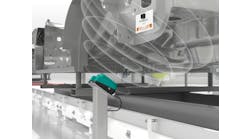In an industry like automation, the fast-paced growth can sometimes leave great ideas in the rearview mirror on the highway of life. Much like the fashion industry, fads can lead certain developments into the mainstream and leave others at the starting gate. One technology that has been around for years, radio frequency identification (or RFID), has withstood the test of time by reinventing itself from time to time.
RFID works on the concept of information stored on data carriers attached to objects that are then exposed to an antenna that extracts the information. It is basically a wireless identification system. To create an RFID system, one needs RFID tags, a read/write device and a host system. The RFID system writes data, provided by the host system to the tag using the write function of the read/write device. Data on the RFID can be read back to the host system and, importantly, data on an RFID is re-writable, meaning it can be overwritten by new data.
The primary uses of RFID technology is in destination determination and historical tracking. An example of destination determination might be an RFID tag attached to a bin on a conveyor sortation system. As the bin passes specific challenge points (just like intersections on a road system), the information contained on the data puck attached to the bin provides information related to the desired destination of the contents of the bin. Asset management is a good example of the use of RFID for historical tracking purposes. An identifiable asset, like a hydraulic pump or a horizontal milling machine, has a permanent RFID tag attached to it. Throughout the lifetime of the asset, the RFID tag is scanned any time part is replaced or a service order is opened. The tag is also scanned as a machine goes in and out of use. The resulting data can be used to determine uptime/downtime, as well as reliability analytics.
Another example of the use of RFID tags can be in a manufacturing process where a part can be tracked as it makes its way through the various workstations from raw material to finished product. Picture an engine block as it starts out in the foundry and stops at the various stations along the path to a finished engine assembly. In this method of tracking, the base object can be taken in and out of the main process with all of the history of the object kept with it.
The use of radio technology means that RFID tags can employ each of the five radio frequencies: low (LF), medium (MF), high (HF), very-high (VHF) and ultra-high (UHF). Radio waves are transmitted in a straight line. High-frequency radio waves are shorter in length, meaning that more data can be transmitted in a shorter time. Low-frequency waves can be transmitted over greater distances because they “string out” their data packages over a longer wave length and are less impacted by terrain (or obstacles). Generally, HF technology is better in conditions where obstacles to “line of sight” might be present but the desire to get great data sent over a short burst (time) is necessary.
RFID systems use one of three methods of transmission: electromagnetic coupling, electromagnetic induction and radio transmission. Coupling uses the lowest frequencies, induction the mid-range frequencies, and radio transmission the highest frequencies. Electromagnetic coupling is limited as it isn’t good at short range from tag to antenna (less than 150 mm). Electromagnetic induction improves transmission at distances of more than 150 mm up to 1 meter, while radio transmission has effective transmission up to 10 meters. To summarize all of this, electromagnetic transmission methods hold up better under “dirty” environments, such as automotive and metal-processing plants, while radio transmission is better where the environment is cleaner, giving the ability to mount the antenna farther away from the tag.
The traditional features of RFID technology help to keep it at the forefront of industry. A tag can be read from and written to without physical contact. This helps to keep the antenna at a safe distance from the process. The combination of an object and its pertinent data means that large data doesn’t have to reside on a data concentrator. The information resides on the tag itself, and the antenna simply accesses that data long enough to determine the next stop in the trip or, alternately, add to the data stream for the object as it moves along the road to the next destination.
At this point in the discussion, it would make sense to bring up some talking points about another identification technology, barcodes. Barcode technology is based on the reading of dark and light regions that are coded to represent numbers and/or letters. Early scanners used oscillating mirrors to deflect light across a coded bar where the receiver would decode the regions of dark and light into an alphanumeric string. Unlike RFID, early bar codes were one-dimensional (or linear) and could be used for little more than a pointer to data that must be stored and retrieved on another device or medium. A common medium was paper, where information was added by means of pen or pencil and a reference code somewhere on the paper record would tie that information to a matching code affixed to the object being tracked.
The need for more prompted the creation of two-dimensional bar codes. These codes combine horizontal and vertical lines to embed data within the code, much like an RFID tag. One very popular 2D code is a QR code. These can be found on products at the retailer and also show up in trade magazines and on ID tags at trade shows. Much like RFID tags, 2D codes can store information relative to the product or person that they are attached to, but, unlike an RFID tag, a 2D bar code only contains information available at the moment that the code is printed. No other information can be added to the code once it is on the package or label. For this reason, you will find 2D bar codes that, when scanned, can automatically direct a smart phone to a Web browser landing on a manufacturer’s website or to an electronic wallet program.
Barcodes rely on data contained in the one-shot printed code to make a connection to a product or service whereas an RFID tag is a read/write device that can grow dynamically to the limits of the embedded memory storage media. Like a prize fighter, RFID keeps coming back for more. With 2D bar codes somewhat leveling the playing field, new technologies have taken RFID to even higher heights, perhaps described best as RFID 2.0.
Unlike barcodes that rely on the coding of 1s and 0s, space-transmission technologies provide a level of data integrity that can’t be reached by barcodes and data protocols specific to RFID transmission results in error detection of less than 1%. Sixteen-bit CRC is added to the data as it is transmitted, adding to the security and accuracy of the data package. RFID doesn’t employ mechanical devices, so the probability of physical malfunction is practically eliminated.
Unlike a barcode that depends on the physical interpretation of coded data, RFID is much more impervious to physical contamination of the tag and antenna. The effects of dirt, water or oil do not impact the capability of the system. Only metal contamination can impact the transmission of data. Because of these qualities, direct line of sight or precise alignment of tag and antenna is not necessary to effectively use the technology.
Some RFID systems even employ antennas that are capable of communicating with multiple tags at the same time, within a similar range to the antenna. This improves the efficiency of the application and eliminates the need to provide a significant range of separation between adjacent objects utilizing RFID tags.
Tags can come in a variety of shapes and sizes to suit the application. Tags can be read-only (RO), write-only, read-many (WORM) or true read/write (R/W). An example of an RO tag would be a tag embedded in a piece of hardware, a WORM tag would be a tag configured with a unique tag within a fleet of tags (like a sorting bin) and an R/W tag could be an asset management tag.
One sector that makes great use of RFID tags is safety guarding. Noncontact guard switches employ RFID to turn what traditionally would have been a proximity switch into a safety device that can only be triggered by the close proximity of an RFID tag that can only be read by an RFID antenna that is looking for the specific data programmed to the read-only tag. Enhanced RFID guard switches can be employed that required the deployment of a tag and antenna that are specifically matched to each other only. Unlike a general RFID guard switch where any antenna in the safety loop can read any matching tag in the same family of antenna/tag pairs, and enhanced RFID tag can only be read by its matching antenna. The code on the tag and in the antenna is unique only to each other.
One final method of employing RFID technology that has gained great general use is key fobs used to permit employee entry to the place of employment or a specific area or room in the place of employment. Machine vendors have adopted this use of the technology to provide machine-specific sign-in management that can be tied to an employee key fob or provide a level of general login based on a user level. In this manner, production employees can log in to general machine operation activities while maintenance and engineers can have access to higher level of functions based on their job functions coded into their employee key fobs.
Over-the-air information transmission (radios and television) seem to be fading from the scene as streaming media gains ground, but radio frequency is alive and well in the controls industry. It will be interesting to see what the future holds for this venerable and ever-evolving technology.






